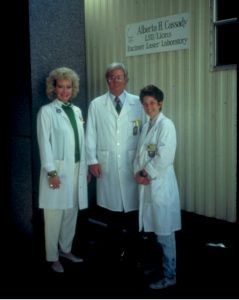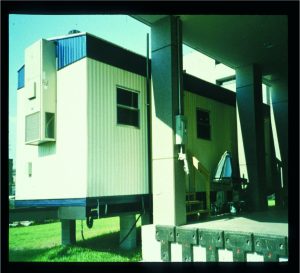[caption id="attachment_14434" align="alignleft" width="1024"]

Mrs Alberta H Cassady 11 days after the world’s first human PRK procedure, just before her exenteration[/caption]
For all the dedicated work by brilliant researchers including Marguerite McDonald MD, Stephen L Trokel MD, Charles R Munnerlyn PhD and Stephen D Klyce PhD, the early development of excimer laser vision correction technology also greatly benefited from the bravery of a dying woman, and the recalcitrance of sanitation engineers at Louisiana State University Health Sciences Center in
New Orleans.

Dr Marguerite McDonald, Dr Stephen D Klyce and
a lab tech standing in front of the laser lab named
after Mrs Cassady
“It’s a great example of the things that can happen when teamwork and serendipity meet up,” Dr McDonald told the International Society of Refractive Surgery Refractive Subspecialty Day at the American Academy of Ophthalmology 2018 Annual Meeting in Chicago, USA.
In her keynote address commemorating the 30th anniversary of the first human photorefractive keratectomy (PRK) procedure, performed by Dr McDonald, she recalled the brave contribution of Alberta H Cassady. Midway through a long series of primate tests under close FDA scrutiny, Mrs Cassady offered for research her normal, healthy, 20/20 eye. It was scheduled for exenteration to treat an advanced orbital tumour with a dire prognosis.
With just 11 days to work with, the development team won emergency FDA permission. On March 25, 1988, Dr McDonald walked Mrs Cassady past cages full of howling and spitting monkeys in the LSU primate vivarium and laid her down under the same industrial-based laser used in animal studies to conduct the world’s first human PRK procedure.
By all accounts the operation, which targeted 4.5 dioptres of myopia, was a success. “We nailed the refractive change,” said Dr McDonald, who now holds clinical professorships at New York University, New York City, and Tulane University, New Orleans, USA. “As she was emmetropic, we made her 4.5 dioptres hyperopic.” In 11 days’ follow-up before the globe was removed, the cornea reepithelialised and healed smoothly and remained clear.
Data from this procedure helped convince the FDA to leapfrog to human blind-eye studies, cutting months, if not years, from the development of laser vision correction, Dr McDonald said. In honour of Mrs Cassady’s bravery and selflessness in submitting to an uncomfortable experimental procedure in the face of a devastating diagnosis, the team named the research lab for her after she died a few months later.
VIBRATING OR
Human trials meant relocating the research lab from LSU’s vivarium across Lake Pontchartrain to its eye centre on campus in New Orleans. But concerned about the possible release of toxic gases, university officials insisted the laser be installed outdoors in a trailer – and the only available space was next to the trash compactor.
Beyond emitting its own noxious gases, the compactor made the ground shake, Dr McDonald said. The engineers operating it would not shut it down during surgery. So, Dr McDonald pulled paper patient records and a mechanical calculator, and set out to prove that the vibrations were damaging clinical outcomes.
“I crunched the numbers and I was sure I was wrong, and I did it all again. I had to admit the stunning truth that the trash compactor patients were doing better – significantly better,” Dr McDonald said. The next day she presented to the team. They, too, were shocked.
The reason quickly became clear. The procedure was being done with a wide-beam laser with a diaphragm stepped down 40 times during the ablation. Vibrations were creating blended zones between the stops that smoothed the surface, Dr McDonald said.
“We started to realise that smoother is better and 40 steps was not enough.”
That led immediately to tripling stops to 120 for wide-beam surgery, and spurred development of flying-spot lasers and the trackers needed to make them work, Dr McDonald added. Improvements followed with increasing rapidity, including LASIK, wavefront- and topography-guided procedures, all the way up to today’s FLEX and SMILE® single-laser procedures, corneal implants and epi-Bowman keratectomy. Indications expanded just as rapidly from low myopia to a wide and growing range of myopic, hyperopic, astigmatic and mixed procedures.
Laser vision correction development is far from over, Dr McDonald predicted.
“After 30 years how do I feel about it now? I think we are just getting started.”
Marguerite McDonald: margueritemcdmd@aol.com

 Mrs Alberta H Cassady 11 days after the world’s first human PRK procedure, just before her exenteration[/caption]
For all the dedicated work by brilliant researchers including Marguerite McDonald MD, Stephen L Trokel MD, Charles R Munnerlyn PhD and Stephen D Klyce PhD, the early development of excimer laser vision correction technology also greatly benefited from the bravery of a dying woman, and the recalcitrance of sanitation engineers at Louisiana State University Health Sciences Center in
New Orleans.
Mrs Alberta H Cassady 11 days after the world’s first human PRK procedure, just before her exenteration[/caption]
For all the dedicated work by brilliant researchers including Marguerite McDonald MD, Stephen L Trokel MD, Charles R Munnerlyn PhD and Stephen D Klyce PhD, the early development of excimer laser vision correction technology also greatly benefited from the bravery of a dying woman, and the recalcitrance of sanitation engineers at Louisiana State University Health Sciences Center in
New Orleans.
 Dr Marguerite McDonald, Dr Stephen D Klyce and
a lab tech standing in front of the laser lab named
after Mrs Cassady
Dr Marguerite McDonald, Dr Stephen D Klyce and
a lab tech standing in front of the laser lab named
after Mrs Cassady